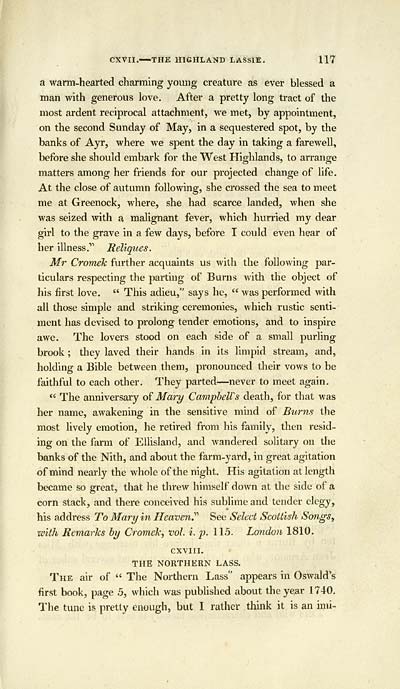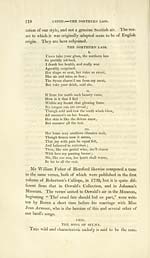Glen Collection of printed music > Printed text > Illustrations of the lyric poetry and music of Scotland
(297) Page 117 - Northern lass
Download files
Complete book:
Individual page:
Thumbnail gallery: Grid view | List view

CXVII.— THE HIGHLAND LASSIE. 117
a warm-hearted charming young creature as ever blessed a
man with generous love. After a pretty long tract of the
most ardent reciprocal attachment, we met, by appointment,
on the second Sunday of May, in a sequestered spot, by the
banks of Ayr, where we spent the day in taking a farewell,
before she should embark for the West Highlands, to arrange
matters among her friends for our projected change of life.
At the close of autumn following, she crossed the sea to meet
me at Greenock, where, she had scarce landed, when she
was seized with a malignant fever, which hurried my dear
girl to the grave in a few days, before I could even hear of
her illness." Reliques.
Mr Cromek further acquaints us with the following par-
ticulars respecting the parting of Burns with the object of
his first love. " This adieu," says he, " was performed with
all those simple and striking ceremonies, which rustic senti-
ment has devised to prolong tender emotions, and to inspire
awe. The lovers stood on each side of a small purling
brook ; they laved their hands in its limpid stream, and,
holding a Bible between them, pronounced their vows to be
faithful to each other. They parted — never to meet again.
" The anniversary of Mary CampheWs death, for that was
her name, awakening in the sensitive mind of Burns the
most lively emotion, he retired from his family, then resid-
ing on the farm of Ellisland, and wandered solitary on the
banks of the Nith, and about the farm-yard, in great agitation
of mind nearly the whole of the night. His agitation at length
became so great, that he threw himself down at the side of a
corn stack, and there conceived his sublime and tender elegy,
his address To Mary in Heaven^'' See Select Scottish Songs,
with Remarks by Cromek, vol. i. p, 115. London 1810.
CXVIII.
THE NORTHERN LASS.
The air of " The Northern Lass" appears in Oswald's
first book, page 5, which was published about the year 1740.
The tune is pretty enough, but I rather think it is an imi-
a warm-hearted charming young creature as ever blessed a
man with generous love. After a pretty long tract of the
most ardent reciprocal attachment, we met, by appointment,
on the second Sunday of May, in a sequestered spot, by the
banks of Ayr, where we spent the day in taking a farewell,
before she should embark for the West Highlands, to arrange
matters among her friends for our projected change of life.
At the close of autumn following, she crossed the sea to meet
me at Greenock, where, she had scarce landed, when she
was seized with a malignant fever, which hurried my dear
girl to the grave in a few days, before I could even hear of
her illness." Reliques.
Mr Cromek further acquaints us with the following par-
ticulars respecting the parting of Burns with the object of
his first love. " This adieu," says he, " was performed with
all those simple and striking ceremonies, which rustic senti-
ment has devised to prolong tender emotions, and to inspire
awe. The lovers stood on each side of a small purling
brook ; they laved their hands in its limpid stream, and,
holding a Bible between them, pronounced their vows to be
faithful to each other. They parted — never to meet again.
" The anniversary of Mary CampheWs death, for that was
her name, awakening in the sensitive mind of Burns the
most lively emotion, he retired from his family, then resid-
ing on the farm of Ellisland, and wandered solitary on the
banks of the Nith, and about the farm-yard, in great agitation
of mind nearly the whole of the night. His agitation at length
became so great, that he threw himself down at the side of a
corn stack, and there conceived his sublime and tender elegy,
his address To Mary in Heaven^'' See Select Scottish Songs,
with Remarks by Cromek, vol. i. p, 115. London 1810.
CXVIII.
THE NORTHERN LASS.
The air of " The Northern Lass" appears in Oswald's
first book, page 5, which was published about the year 1740.
The tune is pretty enough, but I rather think it is an imi-
Set display mode to: Large image | Transcription
Images and transcriptions on this page, including medium image downloads, may be used under the Creative Commons Attribution 4.0 International Licence unless otherwise stated. ![]()
| Special collections of printed music > Glen Collection of printed music > Printed text > Illustrations of the lyric poetry and music of Scotland > (297) Page 117 - Northern lass |
|---|
| Permanent URL | https://digital.nls.uk/91320733 |
|---|
| Description | Scottish songs and music of the 18th and early 19th centuries, including music for the Highland bagpipe. These are selected items from the collection of John Glen (1833 to 1904). Also includes a few manuscripts, some treatises, and other books on the subject. |
|---|
| Description | The Glen Collection and the Inglis Collection represent mainly 18th and 19th century Scottish music, including Scottish songs. The collections of Berlioz and Verdi collected by bibliographer Cecil Hopkinson contain contemporary and later editions of the works of the two composers Berlioz and Verdi. |
|---|

